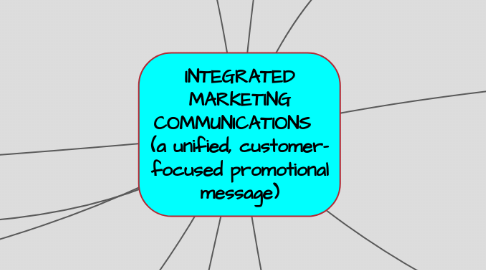
1. PROMOTION (function of informing, persuading, and influencing the consumer's purchase decision)
1.1. OBJECTIVE OF PROMOTION
1.1.1. provide information
1.1.2. increase demand
1.1.3. differentiate the product
1.1.4. accentuate the product's value
1.1.5. stabilize sales
1.2. PROMOTIONAL MIX (subset of the marketing mix in which marketers attempt to achieve achieve the optimal blending of the elements of personal and nonpersonal selling to achieve promotional objectives)
1.2.1. PERSONAL SELLING (A seller’s promotional presentation conducted on a person-to-person basis with the buyer)
1.2.2. NONPERSONAL SELLING
1.2.2.1. advertising
1.2.2.2. product placement
1.2.2.3. sales promotion
1.2.2.4. direct marketing
1.2.2.4.1. functions :
1.2.2.4.2. Direct Marketing via Broadcast Channels (Brief direct-response advertisements on television or radio)
1.2.2.4.3. Electronic Direct Marketing Channels (Represents almost 8 percent of total advertising spending)
1.2.2.4.4. Other Direct Marketing Channels (Print media and other traditional channels are critically important)
1.2.2.5. public relations
1.2.2.6. publicity
1.2.2.7. guerrilla marketing
2. MARKETING COMMUNICATIONS (messages that deal with buyer-seller relationship)
3. DIRECT MARKETING COMMNUNICATION CHANNELS
3.1. Direct mails such as brochures and catalogs
3.2. Telecommunications initiated by companies or customers
3.3. Television and radio through special offers, infomercials, or shopping channels
3.4. Internet via e-mail and electronic messaging
3.5. Print media such as newspapers and magazines
3.6. Specialized channels such as electronic kiosks
4. Pulling and Pushing Promotional Strategies
4.1. Pulling strategy - Promotional effort by the seller to stimulate final-user demand, which then exerts pressure on the distribution channel
4.2. Pushing strategy - Promotional effort by the seller directed to members of the marketing channel rather than final users
5. Measuring the Effectiveness of Promotion
5.1. Direct sales results test - Based on the specific impact on sales revenues for each dollar of promotional spending
5.2. Indirect evaluation - Concentrating on quantifiable indicators of effectiveness such as recall and readership
6. IMPORTANCE
6.1. SOCIAL
6.1.1. What appeals to one group of consumers may seem tasteless to another
6.1.2. One generally accepted standard in a market society is freedom of choice for the consumer
6.1.3. Promotion performs an informative and educational task crucial to the functioning of modern soc
6.2. BUSINESS
6.2.1. Long-term increase in funds allocated to promotion indicates faith in its ability to encourage attitude changes, brand loyalty, and additional sales
6.3. ECONOMIC
6.3.1. Provides employment for millions of people
6.3.2. Increases units sold and allows economies of scale in production process
6.3.3. Subsidizes information content of newspapers and broadcast media
7. HOW SPONSORSHIP DIFFER FROM ADVERTISING
7.1. Sponsor’s degree of control versus that of advertising
7.2. Nature of the message
7.3. Audience reaction
8. THE COMUNICATION PROCESS
8.1. SENDER (seeks to convey a message to the receiver)
8.2. MESSAGE (communication of information, advice or a request by the sender to the receiver)
8.3. A.I.D.A (step an individual reahes a puchase decision -Attention, Interest, Desire, Action)
8.4. ENCODING (translating a message into understandable terms)
8.5. DECODING (receiver's interpretation of a message)
8.6. FEEDBACK (receiver's response to a message)
8.7. NOISE (any stimulus that distracts a receiver from receivering a message)
9. IMC
9.1. personal selling
9.2. public relations
9.3. sales promotion
9.4. direct mail
9.4.1. advantages
9.4.1.1. Ability to select a narrow target market
9.4.1.2. Achieve intensive coverage
9.4.1.3. Send messages quickly
9.4.1.4. Choose from various formats
9.4.1.5. Provide complete information
9.4.1.6. Personalize each mailing piece
9.4.1.7. Response rates are measurable and are higher than other types of advertising
9.4.1.8. Do not compete for attention
9.4.2. disadvantages
9.4.2.1. Per-reader cost is high
9.4.2.2. Effectiveness depends on the quality of the mailing list
9.5. sponsorships
9.5.1. Access to the event’s audience
9.5.2. The image associated with the activity

